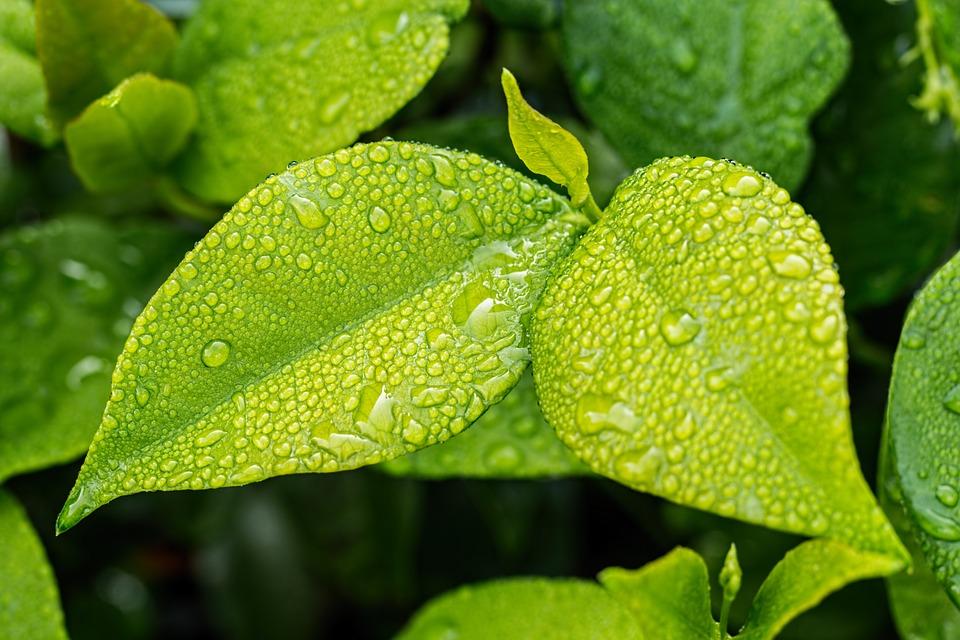
There are two different steps or parts of photosynthesis. These two parts of photosynthesis are the light dependent reactions and the light-independent reactions. The light-independent reactions are also referred to as the Calvin cycle. In the light-dependent reactions, electron carrier molecules such as NADPH and ATP are formed by the conversion of sunlight into chemical energy, after the sunlight is absorbed by chlorophyll. In the light-independent reactions, the chemical energy obtained through the light-dependent reactions is used to assemble carbohydrate molecules. The two systems used to accomplish photosynthesis are referred to as photosystems.
To understand how these photosystems/photosynthetic process works, it will be beneficial to examine the reactants of the photosynthetic process and explore how these reactants are manipulated by the photosystems.
Reactants Of Photosynthesis
The reactants of photosynthesis are water, sunlight, and carbon dioxide. Plant cells take in water, sunlight, and carbon dioxide in order to create energy. Reactants are the inputs of the photosynthesis process, and the outputs or products of photosynthesis are glucose and oxygen. The chemical equation for photosynthesis can be represented like this:
6 CO2 + 6 H2O → C6H12O6 + 6 O2
You can interpret this equation to mean that carbon dioxide (or CO2) and H2O (or water) are used to create C6H1206 (or sugar) and O2 (or oxygen). Carbon dioxide is emitted by many different organisms during the process of cellular respiration or fermentation. Plants absorb carbon dioxide through things called stomata, tiny holes present within the leaves of the plant. Once the cells of the plant absorb the carbon dioxide, the chloroplasts within the cell use it to power photosynthesis and create carbohydrates.
Oxygen is used by vertebrates to breathe and drive their cellular processes, while C6H1206 can actually refer to many different molecules, depending on the arrangement of the atoms within the molecule. However, most of the molecules that have this specific formula are a type of sugar, with the most common type of sugar of this formula being glucose. These cells of animals use glucose to generate ATP, the energy they need.
Chloroplasts, Pigments, And Photosynthesis
Photosynthesis is the process plants undergo to derive energy from sunlight, water, and carbon dioxide. Algae, plants, and a type of bacteria known as cyanobacteria are the only organisms that can carry out photosynthesis. These photosynthetic organisms are referred to as “photoautotrophs”, which distinguishes them from a different group of bacteria that is capable of extracting energy from inorganic compounds – chemoautotrophs. Chemoautotrophs derive their energy from the synthesis of sugars and not from the energy of the sun.
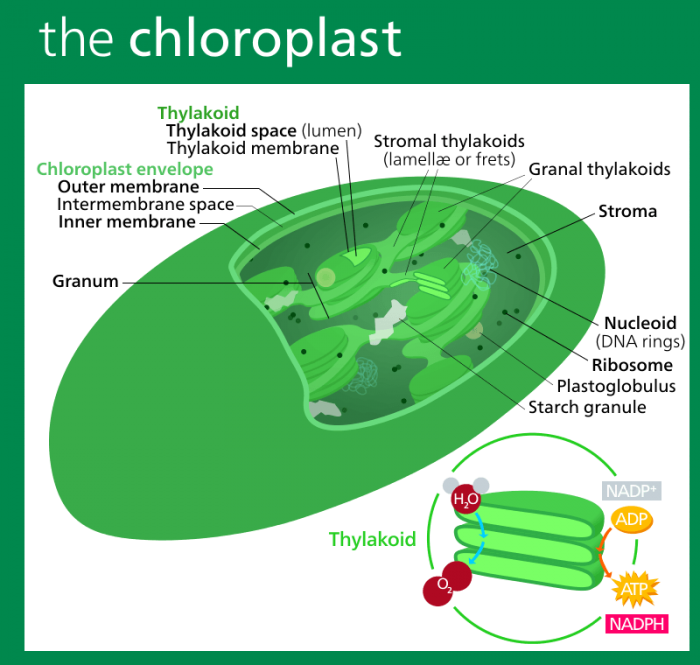
Photo: By Kelvinsong – Own work, CC BY 3.0, https://commons.wikimedia.org/w/index.php?curid=26247252
The actual organelles in the cell that carry out the photosynthesis are chloroplast. Chloroplasts are filled with a pigment called chlorophyll. This pigment absorbs certain regions of the electromagnetic radiation spectrum, certain wavelengths of light. This pigment is also what results in algae and plants having their green color. Photosynthesis in plants typically occurs in the leaves of the cell, and the leaf of the plant is made out of different layers of cells. The middle layer of the leaf if called the mesophyll and it is here that photosynthesis takes place. Meanwhile, the exchange of gases (the exchange of oxygen and carbon dioxide) happens via small openings in the leaf called stomata. These stomata are usually found on the leaf’s underside.
Chloroplasts are the organelle that makes usable energy out of light energy. The light absorbed by the chloroplasts will be stored in organic molecules like sugar, which the cell can then use for energy. The light energy is transformed into ATP (or adenosine triphosphate. In addition to chlorophyll, carotenoids are another type of pigment that can form nicotinamide adenine dinucleotide phosphate (or NADPH). This NADPH is an electron transport molecule. During the Calvin cycle, the electrons being transported by NADPH will be used to create carbohydrates, and this transformation is known as CO2 fixation.
Chlorophylls have two membranes, much like mitochondria do. The chloroplast’s inner membrane is dubbed the stoma and within it are stacks of structures called thylakoids. Thylakoids are the structures that have the chlorophylls within them, and they are arrayed on top of one another in a clump called a granum. There are different types of thylakoids, such as granal thylakoids and stroma thylakoids. Within the chloroplast is also an irregularly shaped region of genetic material dubbed the nucleoid, which can be found in most prokaryotic cells. Within the chloroplasts, the nucleoids are arrayed in ring shapes. The interior of the chloroplast also contains plastoglobules, lipid bodies that are associated with the biosynthesis of tocopherols. There are also starch granules in the chloroplast, semi-crystalline granules made out of different glucose polymers, and they serve to store carbon in plants.
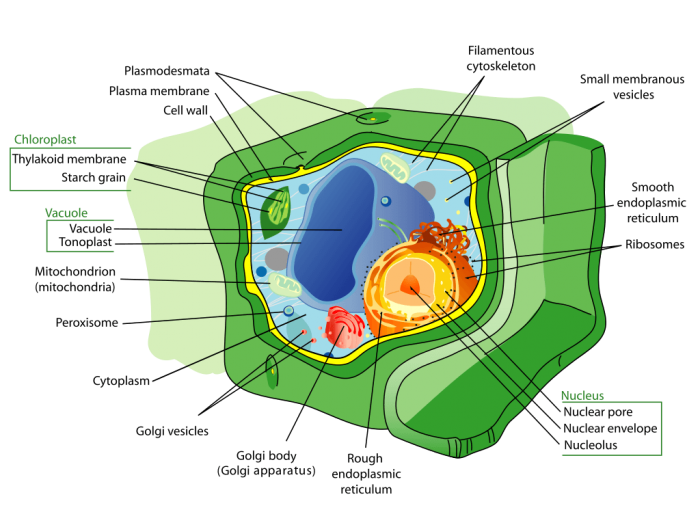
Photo: By LadyofHats – Self-made using Adobe Illustrator. (The original edited was also made by me, LadyofHats), Public Domain, https://commons.wikimedia.org/w/index.php?curid=844682
The stroma is an area of the chloroplast that engineers carbohydrates, and it contains ribosomes and chunks of DNA within it. The fact that these stroma have ribosomes and DNA is one of the reasons it is theorized that chloroplasts are the result of a long process of evolution that had free-living bacteria evolve into chloroplasts via a symbiotic relationship with other cells. It is theorized that the chloroplast precursors were cyanobacteria that lived inside cells, producing energy in return for a safe environment to live in. Chloroplasts don’t merely have their own DNA, they also reproduce through binary fission, the exact way that bacteria reproduce.
Other Kinds Of Plastids
Different pigments can absorb different wavelengths of light, meaning that plants with other plastids or pigments can absorb different parts of the light spectrum. The color of a plant is dependent on the pigment it uses. Even the most plants are green, there are other pigments such as phycobilins and carotenoids they can give plants different colors, Phycobilins are either red or blue, and they are capable of absorbing the blue, orange, and red parts of the light spectrum. In contrast, carotenoids are yellow, red, or orange and they absorb light in the green or blue wavelengths of the spectrum.
The Two Photosystems
As is implied by their names, the light-dependent reactions need sunlight to operate, while the light-independent reactions don’t need sunlight. In the light-dependent photosystem, chlorophyll absorbs sunlight and converts it into chemical energy the cell can use storing it in the form of the molecule ATP or the electron carrier molecule and a DPH. These light-dependent reactions happen within the chloroplast, in the structures called thylakoids.
The process responsible for the conversion of light energy into chemical energy happens in a photosystem, a complex made up of multi-proteins. Within the membrane of the thylakoid, there are two types of photosystems: Photosystem II and Photosystem I. Each of these photosystems absorbs the energy released by excited electrons, the energy coming from sunlight. The energy carrier molecules transport the electrons to other parts of the cell, where the electrons will be used to power the light-independent system.
The Relationship Between Photosynthesis And Cellular Respiration
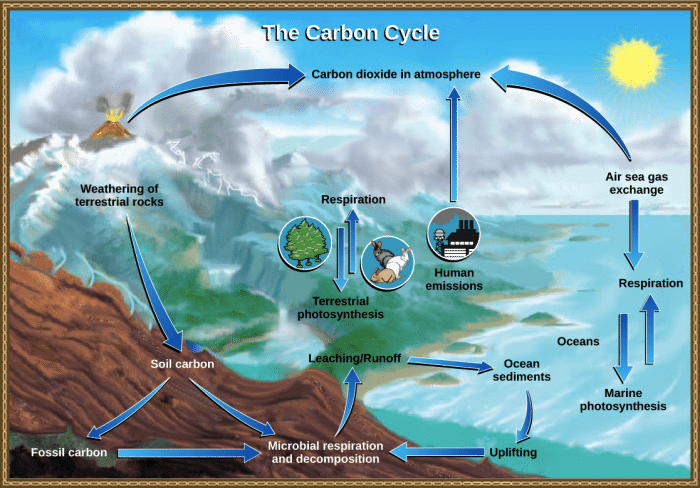
Photo: Cellular respiration and phtosynthesis are opposite of one another and part of the carbon cycle. Photo: OpenStax College, Biology/CC-BY 4.0
Let’s take a look at the equation for photosynthesis: 6CO2 + 6H2O → C6H12O6+ 6O2
Meanwhile, here is the equation for cellular respiration: C6H12O6 + 6O2 → 6CO2 + 6H2O
As you can see, the two reactions are the inverse of one another. While photosynthesis takes in water and carbon dioxide and releases oxygen and glucose, cellular respiration does the opposite. Cellular respiration releases water and carbon dioxide. Animal cells use hydrogen and oxygen, so they form water as a byproduct. Meanwhile, when ATP is synthesized from glucose it is transformed into carbon dioxide. The relationship between cellular respiration and photosynthesis constitute the “carbon cycle”, a system that enables molecules of carbon to cycle through the biosphere, moving from plants to animals and back again. Plants get carbon dioxide from the atmosphere, which is released into the atmosphere by the cellular respiration of animals.
The Differences Between Plants And Animal Cells
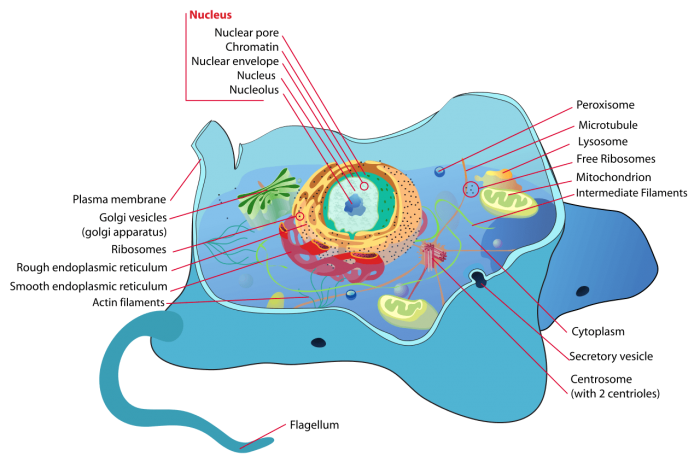
Photo: By LadyofHats (Mariana Ruiz) – Own work using Adobe Illustrator. Image renamed from Image:Animal cell structure.svg, Public Domain, https://commons.wikimedia.org/w/index.php?curid=4266142
Both animal cells and plant cells have organelles which collectively handle the production of energy. Animal cells have mitochondria within them, and these mitochondria use oxygen and glucose to create energy, water, and carbon dioxide. In contrast, plants have chloroplasts. You should be aware that plant cells possess mitochondria in addition to chloroplasts, but animals cells do not have chloroplasts. The mitochondria that plant cells have function somewhat differently than the mitochondria animal cells possess. In animal cells, the mitochondria fulfill two roles – the production of energy and aerobic respiration. Meanwhile, plant cells have mitochondria that only carry out respiration. As we can see, the animal cells and plant cells exist in a system of delicate balance, where the products of one system are the inputs of the other system. Neither animal cells or plant cells could exist without the other type of cell to support it.









